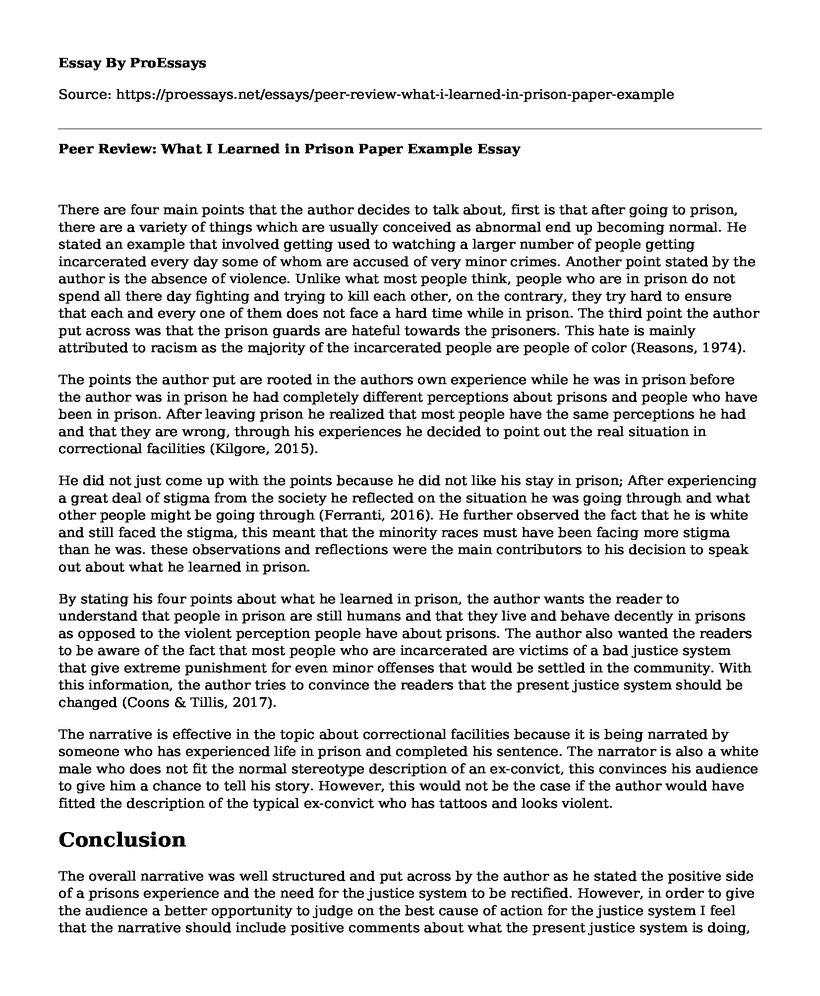There are four main points that the author decides to talk about, first is that after going to prison, there are a variety of things which are usually conceived as abnormal end up becoming normal. He stated an example that involved getting used to watching a larger number of people getting incarcerated every day some of whom are accused of very minor crimes. Another point stated by the author is the absence of violence. Unlike what most people think, people who are in prison do not spend all there day fighting and trying to kill each other, on the contrary, they try hard to ensure that each and every one of them does not face a hard time while in prison. The third point the author put across was that the prison guards are hateful towards the prisoners. This hate is mainly attributed to racism as the majority of the incarcerated people are people of color (Reasons, 1974).
The points the author put are rooted in the authors own experience while he was in prison before the author was in prison he had completely different perceptions about prisons and people who have been in prison. After leaving prison he realized that most people have the same perceptions he had and that they are wrong, through his experiences he decided to point out the real situation in correctional facilities (Kilgore, 2015).
He did not just come up with the points because he did not like his stay in prison; After experiencing a great deal of stigma from the society he reflected on the situation he was going through and what other people might be going through (Ferranti, 2016). He further observed the fact that he is white and still faced the stigma, this meant that the minority races must have been facing more stigma than he was. these observations and reflections were the main contributors to his decision to speak out about what he learned in prison.
By stating his four points about what he learned in prison, the author wants the reader to understand that people in prison are still humans and that they live and behave decently in prisons as opposed to the violent perception people have about prisons. The author also wanted the readers to be aware of the fact that most people who are incarcerated are victims of a bad justice system that give extreme punishment for even minor offenses that would be settled in the community. With this information, the author tries to convince the readers that the present justice system should be changed (Coons & Tillis, 2017).
The narrative is effective in the topic about correctional facilities because it is being narrated by someone who has experienced life in prison and completed his sentence. The narrator is also a white male who does not fit the normal stereotype description of an ex-convict, this convinces his audience to give him a chance to tell his story. However, this would not be the case if the author would have fitted the description of the typical ex-convict who has tattoos and looks violent.
Conclusion
The overall narrative was well structured and put across by the author as he stated the positive side of a prisons experience and the need for the justice system to be rectified. However, in order to give the audience a better opportunity to judge on the best cause of action for the justice system I feel that the narrative should include positive comments about what the present justice system is doing, for instance, it provides a good way to keep dangerous criminal from the society, it also rehabilitates offenders to help them become productive people in society (Whitaker, 2018).
References
Coons, C., & Tillis, T. (2017). America's criminal justice system is broken. Retrieved from https://edition.cnn.com/2017/01/09/opinions/america-needs-criminal-justice-reform-coons-tillis/index.html
Ferranti, S. (2016). The Stigma of Being an Ex-Con | The Fix. Retrieved from https://www.thefix.com/stigma-being-ex-con
Kilgore, J. (2015). What I Learned in Prison by James Kilgore | Freedom Never Rests. Retrieved from http://www.freedomneverrests.com/2015/08/04/what-i-learned-in-prison-by-james-kilgore/
Whitaker, C. (2018). Retrieved from https://legalbeagle.com/7577128-good-things-criminal-justice-system.htmlReasons, C. (1974). Racism, prisons, and prisoners' rights. Issues Criminology, 9, 3.
Homant, R., & Kennedy, D. (1982). Attitudes toward ex-offenders: A comparison of social stigmas. Journal Of Criminal Justice, 10(5), 383-391. doi: 10.1016/0047-2352(82)90021-6
Cite this page
Peer Review: What I Learned in Prison Paper Example. (2022, Sep 11). Retrieved from https://proessays.net/essays/peer-review-what-i-learned-in-prison-paper-example
If you are the original author of this essay and no longer wish to have it published on the ProEssays website, please click below to request its removal:
- Illegal Immigrants Should Have the Same Rights as Everyone in America - Essay Sample
- The Fifth Amendment - Essay Sample
- Essay Example on Tech Crime: Balancing Justice and Security With New Technologies
- Essay Example on Zero Tolerance for Plagiarism: Safeguarding Academic Integrity
- Essay Sample on The Role of Courts in Our World
- Cyberstalking: Fraud, False Allegations & Threats - Essay Sample
- Essay Example on LGBT Rights: Progress Amidst Controversy







